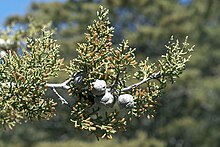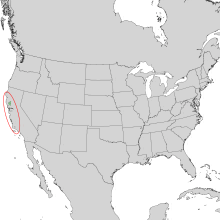Hesperocyparis sargentii
| Hesperocyparis sargentii | |
|---|---|

| |
| Scientific classification | |
| Kingdom: | Plantae |
| Clade: | Tracheophytes |
| Clade: | Gymnospermae |
| Division: | Pinophyta |
| Class: | Pinopsida |
| Order: | Cupressales |
| Family: | Cupressaceae |
| Genus: | Cupressus |
| Species: | C. sargentii
|
| Binomial name | |
| Cupressus sargentii Jeps. 1909
| |

| |

| |
| Natural range | |
| Synonyms[1] | |
| |
Cupressus sargentii is a species of conifer in the Cupressaceae family known by the common name Sargent's cypress. It is endemic to California, where it is known from Mendocino County southwards to Santa Barbara County. This taxon is limited to the Coast Range mountains. It grows in forests with other conifers, as well as chaparral and other local mountain habitat, usually in pure stands on serpentine soils. It generally grows 10 to 15 meters (33-50 feet) tall, but it is known to exceed 22 meters (73 feet). On Carson Ridge in Marin County, as well as Hood Mountain in Sonoma County, the species comprises a pygmy forest of trees which do not attain heights greater than 240-360 cm (8-12 feet) due to high mineral concentrations in the serpentine soil. [2]
One notable population occurs in the Cedar Mountain Ridge area of Eastern Alameda County. According to Carl Wolf, who extensively studied the New World Cypress in the 1930s and 1940s, seed from the Cedar Mountain stand of Cupressus sargentii produced the most vigorous seedlings.
Like many of the New World Cupressaceae, Sargent Cypress usually reproduces with the aid of wildfire, which cause an opening of the cones and exposure of bare mineral soil for seedling germination, though occasionally seeds will fall and germinate without fire, though such seems to be the exception rather than the rule. It is often the case that many trees in a particular stand will all be the same age, so that a sort of stratification occurs of different colonies all of the same age. Sargent Cypress can begin producing cones as early as five or six years of age. [3]
References
- ^ The Plant List, Cupressus sargentii Jeps.
- ^ Biohere, Hood Mountain Park
- ^ Wolf, C. B. & Wagener, W. E. (1948). The New World cypresses. El Aliso 1: 195-205.
Further reading
- Conifer Specialist Group 1998. Cupressus sargentii. 2006 IUCN Red List of Threatened Species. Downloaded on 10 July 2007.
- Forest Service Fire Ecology
- Wolf, C. B. & Wagener, W. E. (1948). The New World cypresses. El Aliso 1: 195-205.

